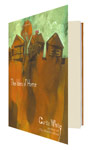
White starts his novel by pulling a Magritte. “This Is Not an Autobiographical Statement” is the first chapter of what otherwise seems to be the autobiographical statement of a man named Curtis White, focusing specifically on his “hometown,” a suburban no-place called San Lorenzo.
We expect autobiographical fiction to come from some sort of childhood trauma—you’re upset about your crummy life, and writing a book is cheaper than therapy—but the narrator of The Idea of Home seems upset that his childhood wasn’t traumatic enough. Sterile San Lorenzo denied him the sex and death and filth a growing boy needs, and so he’s had to go back and make it all up. The first sentence of the second chapter, “Boy Finds Body”: “I never found a body when I was a boy”; he then goes on to tell us about the time he found a body when he was a boy. Each chapter is an anecdote or series of anecdotes—personal, historical, fictional—that at some point lurches into a grotesque fantasy, filthier and nastier but somehow more honest than the facts on the ground level of contemporary suburbia. A factual, if somewhat wry, portrait of South Vietnam’s “Dragon Lady” Madame Nhu warps into the story of a boy who buys a miniature, naked, caged Madame Nhu for $37.95 on the street and takes her home as a pet. And it’s uglier than it sounds.
I wish I could avoid using the P-word here. Whos ever benefited from the comparison? But between the Lot 49-style NoCal geography and these Gravity’s Rainbow-style phantasmagorias, I really can’t get around it: Pynchonesque. I am going to admit that The Idea of Home is pleasingly Pynchonesque.
That’s not to say that White’s sentences always enjoy a Pynchonesque felicity. Sometimes his prose smells more like the pages of a hip glossy magazine than those of an avant-garde novel:
Do you remember Miss Nancy on Romper Room, how she was able to see us all on the other end of the television waves through her Magic Mirror?… Of course, our television screen, too, was a magic mirror where I was he as you were he and we were all together.
Ouch! He was on a roll, and then, clunk, that Beatles reference. And the very end of the novel (“Paris, 1873”) seems less a realization of narrative/metanarrative necessity than of ideology: White’s book of essays, Monstrous Possibility, was a sort of manifesto towards a new novel, and the conclusion of The Idea of Home smacks of an attempt to locate himself within a theory of art. Still, it’s hard to begrudge White these small lapses when the book as a whole is so uncompromisingly inventive and yet so seamlessly fitted together.
Take that “I Am the Walrus” line. Much as I cringed when I ran across it, it made more sense as the novel’s agenda emerged. One of White’s key notions is the fleeting possibility of transcendence that appeared in radical sixties culture, and mind-altering drugs crop up repeatedly throughout the novel; Magical Mystery Tour is an ideally chosen point of reference. This is one bad trip, true, but a chemically induced psychosis might be just enough to bring us back from our post-television moment to an authentic point of origin. The very idea of “home” is a fantasy, a nightmare, a hallucination; The Idea of Home is the ritual that brings it to life.





